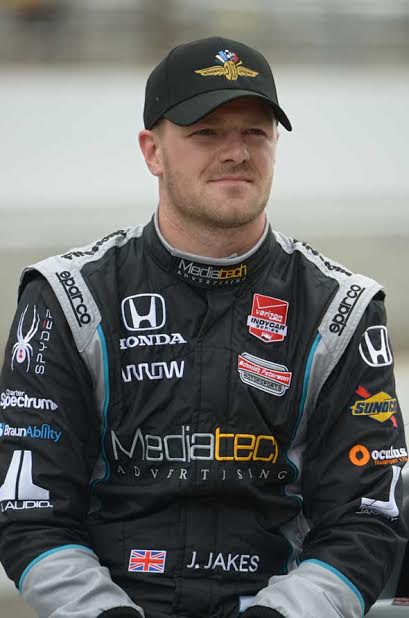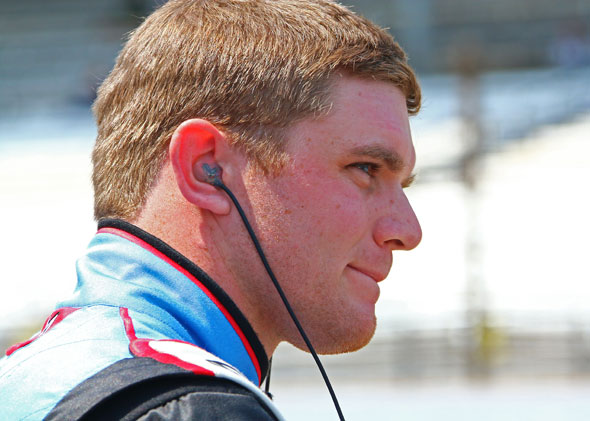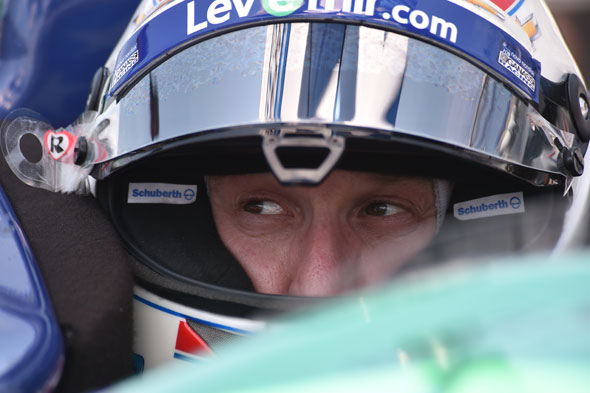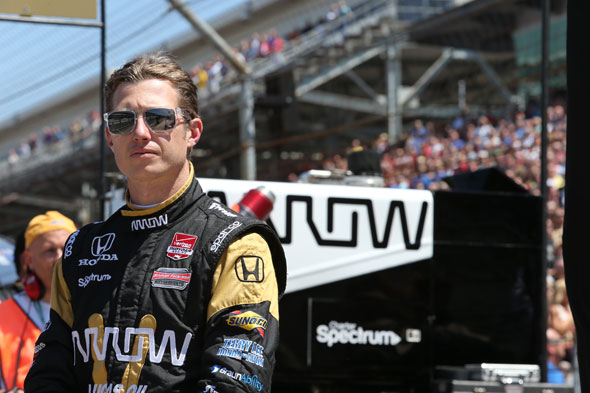The Racers’ Edge
Indianapolis, Thursday May 21 — The track at the Indianapolis Motor Speedway is fairly quiet, until it isn’t. Drivers are doing practice runs and each time one goes by, the air is scorched by the noise. Or maybe a better word is ripped. The human reaction to the din is purely physical. One is instinctively on alert — it’s an adrenaline burst. Yet when you meet the drivers, you are struck by how calm they are — not at all like the thrill-seekers one has known. Which is a reminder that this is not a game; it’s a job. Here’s how the fastest drivers in the world go to work.
James Jakes

“The most nerve-wracking part of the race is the lead up into it.” —James Jakes
(Photo by Walter Kuhn)
James Jakes was born in Great Britain. The 27-year-old started racing in 2002 and began driving IndyCars in 2011.
The Saturday Evening Post: To an average person, it would seem thrilling, even terrifying, to ride at these speeds.
JJ: To be honest it just comes very naturally. You’re doing so much more in the car than just driving. You know, you have all your tools to play with in the car, you’re getting instructions from your team, not only about your position but about your engine, and much more, so the driving comes naturally really. You just fall into a groove.
SEP: You’re calm?
JJ: Yes, the worst part, the most nerve-wracking part of the race is the lead up into it. As soon as the green flag goes, everyone’s in their element. You just get in the car and do what you have to do. Actually, on Sunday I will be wearing a heart rate monitor, so you’ll be able to see how calm I am.
Conor Daly

“You’re fully fueled by adrenaline.” —Conor Daly
(Photo by Mike Harding)
Conor Daly, 23, is the son of professional race car driver Derek Daly. He started racing go-karts as a 10-year-old, and in 2005 Kart Racers of America named him Junior Driver of the Year. In 2008, he graduated to race cars. He made his debut in IndyCars in 2013.
SEP: How important is fitness? To the average person, you’re just driving a car.
CD: Exactly! That’s the biggest thing we try to change people’s thoughts on. We train every day. It’s not just your arms or your neck, it’s also your legs, your core. You’re putting 1,500 pounds of pressure on the break pedal every lap.
SEP: Traveling that speed, do you have a sense of the adrenaline rush?
CD: You’re fully fueled by adrenaline. When you’re at that limit, you’re at the verge of life or death — because in the end it is a dangerous sport. That’s part of the reason I love racing — the adrenaline, the fear, the speed. So you definitely feel it. Especially here. The first time I raced at Indy, every lap I was thinking to myself, You know what? This is pretty fast! And I love it. I love every bit of it.
SEP: You’re from a racing family. How important is that?
CD: My dad was a racer. And I have racing in the family, racing in the blood. He was my manager for a long time. He guided me through the road to get here. And he’s a smart guy.
SEP: What specifically would he tell you after a race?
CD: He’s not intrusive, but after a race he may say, “You know what, here’s what this guy was doing.” Or “You might not have seen this line” or whatever. So it’s cool to have him on my side.
SEP: What’s the main difference between highway driving and racing?
CD: Everything. It’s literally a world of difference.
SEP: Yeah, but anyone can get in a car and drive really fast.
CD:Okay, here’s a good way to think of it. Every car does the same thing. It goes, it stops and it turns left and right. Ours do the same thing, but at a lot faster rate. I can’t even begin to describe the difference that makes.
Charlie Kimball
 “It [diabetes] does not define me, but it’s part of the description of who I am.” —Charlie Kimball
“It [diabetes] does not define me, but it’s part of the description of who I am.” —Charlie Kimball
(Photo by Dana Garrett)
Charlie Kimball has been racing Indy cars since 2011. He is also the first licensed driver with diabetes in the history of IndyCar racing.
SEP: How does your diabetes affect your driving?
CK: Diabetes is not part of the conversation, because if I do my job right, it literally is just another part of me. I’m Charlie Kimball. I was born in England; I grew up in America; I’m married; I have diabetes. It does not define me, but it’s part of the description of who I am.
Ryan Briscoe
 “To get called up because of something like that sort of tames your excitement a little bit.” —Ryan Briscoe
“To get called up because of something like that sort of tames your excitement a little bit.” —Ryan Briscoe
(Photo by Chris Jones)
33-year-old Ryan Briscoe replaced James “Hinch” Hinchcliffe, who suffered a horrific crash that very nearly took his life during an Indy 500 practice on Monday, May 18, before the race. Briscoe, an Australian IndyCar driver with 129 total starts and seven victories, got a last-minute call to fill the seat. Sunday will be his 10th appearance at the 500. In previous starts, he finished fifth twice.
SEP: What’s it like to come in on such short notice?
RB: I’m excited to be the one to have been chosen to fill in for Hinch. But to get called up because of something like that sort of tames your excitement a little bit. It’s terrible for Hinch and my thoughts are with him. And fortunately he’s doing great — he’s recovering already better than anyone expected. Which is really fantastic news.
SEP: How challenging is this situation workwise? Practicing for an hour before the biggest race day in the world?
RB: At this point my mind’s on the race and hopefully I’ll go out and do a good job. I’m comfortable. There’s not a funny feeling about the car. I feel good about it. Got familiar with the buttons on the steering wheel, and you know, braking coming into the pits, and doing a couple of pit stops. I’ve just got to be really focused in next couple days so I don’t miss anything that’s important, and so I don’t find myself scratching my head about something on Sunday.
SEP: What about the suit you’re wearing? Did they make it for you on short notice?
RB: It’s Hinch’s and it fits perfect! Next time I get something made, I’ll just say, “give me Hinch’s measurements.” I’ve never measured myself for a suit and had it fit as well as this one does.
SEP: Can you talk about the physical fitness that is required of a driver?
RB: Fitness is a big part of our lives. It’s kind of like our everyday job is being in the gym and working out, and the fun part of the job is going to the racetrack and driving race cars. For these cars, probably more than for any other race car in the world, I’d say, pure strength is important. We don’t have power steering. We’ve got so much downforce coming through the steering column; it’s like driving a 5-ton truck basically. So, you need to be strong, but you also need endurance. This race is more mentally fatiguing than physically fatiguing. You have to be mentally prepared to maintain that concentration for such a long time at these speeds. Any little mistake is very costly.